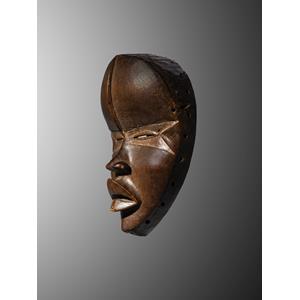IMAGE DETAILS

Claes Gallery
Dan 'deangle' Mask
Ivory Coast, Dan people
Presumed early 20th century
Wood and pigment
H 25 cm
Provenance: Hubert Goldet (1945–2000), Paris, until 1972; Lucien Van de Velde (1933-), Antwerp, from 1972 to 1975; René (1901-1998) & Odette (1925–2012) Delenne, Brussels
Literature: Arts d’Afrique Noire 34, 1988, p. 49; Utotombo, Kunst uit Zwart-Afrika in Belgisch privé-bezit, de Heusch, Brussels, 1988, p. 148, fig. 59; A ‘Harley Mask’ at the Cleveland Museum of Art: More on Masks among the Mano and Dan Peoples, Petridis, African Arts, Vol. 45, n° 1, 2012, p. 31, fig. 8; Trésors de Côte d’Ivoire, Neyt, Fonds Mercator, Brussels, 2014, p. 44-45, fig. 18 (indication: H. 26 cm); The Language of Beauty in African Art, Petridis, The Art Institute of Chicago, 2022, p. 207, fig. 164
Exhibitions: Utotombo. Kunst uit Zwart-Afrika in Belgisch privé-bezit, Palais des Beaux Arts, Brussels, 25 March-5 June 1988; The Language of Beauty in African Art, The Art Institute of Chicago, Chicago, 20 January 2022-27 March 2023
Originating from the northwest of Côte d’Ivoire, near the borders of Liberia and Guinea, the Dan are an agricultural people who primarily cultivate rice and cassava. Their way of life, complemented by hunting, fishing, and gathering, is rooted in a patrilineal society without a central authority, structured around clans led by chiefs chosen for their prestige, bravery, or agricultural success. Relations between clans, often marked by rivalries, gave rise to a rigorous social organization: young warriors ensured the group’s defense, while chiefs reinforced their influence through feasts and gifts. Local power rested on a balance between the chief, the council of elders, and the male associations, which upheld discipline, guided the initiation of young men, and preserved community cohesion.
The Dan distinguish between two worlds: that of the village - a humanized and social space - and that of the forest, the realm of spirits and natural forces. It is within this duality that their art takes root, renowned for its independence and for the diversity of its styles from one village to another. In their pursuit of formal perfection, Dan artists express through their works an ideal of beauty that is both spiritual and harmonious.
A symbol of this aesthetic quest, the Dan 'deangle' mask is characterized by its regular oval shape, polished surface, narrow eyes, short nose, and full, slightly parted lips. The raised scarifications emphasize the geometry and graphic strength of the composition. Of an elegance imbued with softness and femininity, it embodies the Dan ideal of beauty. Used within the Leopard secret society (go), associated with the pacifying spirit zlan, this mask served as an intermediary between young initiates and the village community.
First exhibited and published for the general public in 1988, this exceptional work was most recently presented (in 2022) at the Chicago Museum. The mask’s deep gaze, highlighted by a fine band across the eyes, captures the viewer’s attention. Its patina, with warm brown reflections, and its concave form lend it a presence that is both powerful and serene.



 download image
download image